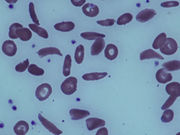But treatment has only been given to one patient so far
THURSDAY, March 2, 2017 (HealthDay News) — In a brief report published in the March 2 issue of the New England Journal of Medicine, researchers detail their early success using gene therapy to treat, or even potentially cure, sickle cell disease.
A team, led by Marina Cavazzana, M.D., Ph.D., of the Necker Hospital for Sick Children in Paris, focused on beta globin. First, the researchers extracted a stem cell supply from their adolescent patient’s bone marrow, before using chemotherapy to wipe out the remaining stem cells. Then they used a modified virus to deliver an “anti-sickling” version of the beta globin gene into the stem cells they’d removed before chemotherapy. The modified stem cells were infused back into the patient.
Over the next few months, the male patient showed a growing number of new blood cells bearing the mark of the anti-sickling gene. The result was that roughly half of his hemoglobin was no longer abnormal.
“Longer follow-up is required to confirm the durability of the efficacy and safety profile observed, and data from additional evaluations of gene therapy in a larger cohort of patients to confirm the promise of gene therapy for sickle cell disease are lacking,” the authors write.
The study was partly funded by Bluebird Bio, the company developing the therapy.
Copyright © 2017 HealthDay. All rights reserved.








